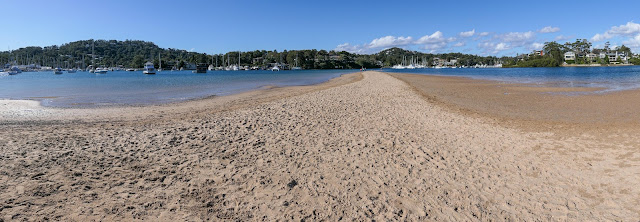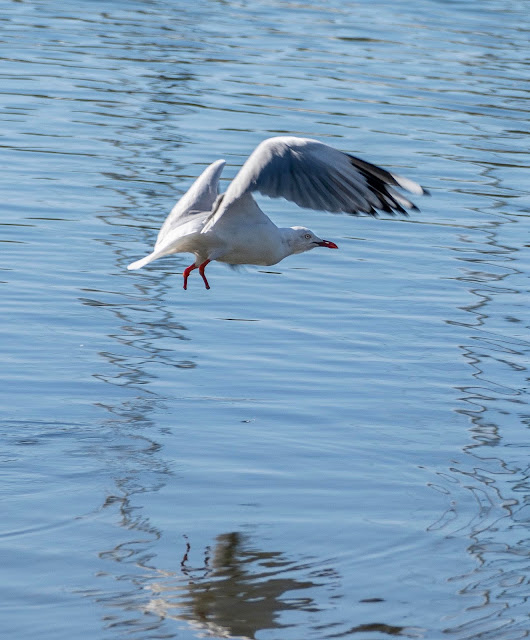Setting up the Panasonic Lumix FZ1000.2 Part 2 The Menus 21 June 2019
 |
| Panasonic cameras including the FZ1000.2 have very good auto pano capability. |
My apologies for the boring nature of this post. But menus are like that. Also apologies for the cryptic nature of some of my comments. I lack the energy to fully discuss the pros and cons of every option.
The FZ1000.2 has Panasonic’s recently re-vamped menu system with a very nice graphic user interface, submenus in the Custom tab and a My Menu.
There is still room for further improvement however. I would like to see the whole menu system revised from scratch with a new set of submenus based on more photographer relevant categories.
The basic outline for my suggestion for these is something like:
Setup>General/Controls/Viewing/Files
Capture>Image/Focus/Exposure/Drive
Movie
Review
Connect
As it stands the submenus [camera] and [custom] don’t really mean anything. All the other camera makers present the user with the same kinds of issues in the menus.
In this post I will not deal with Movie or Playback menus.
Setup
I will only refer to items about which I think I have something to contribute beyond that which you can find in the Operating Instructions for Advanced Features which you can find as a PDF online and download. At 326 pages it is actually quite modest compared to some others, well written with good graphics and easy navigation around the PDF.
I set Monitor and LVF display speed to 60 fps for better display when panning.
Monitor display (note this switches to LVF display when you look in the viewfinder)
I have thus far left the Monitor and LVF (EVF) at default settings which appears to give a nice result.
Monitor luminance I leave at default which is [Auto].
Eye sensor sensitivity LOW.
LVF/Monitor Switch [LVF/MON AUTO]
I bring Format up to My Menu because I use this command frequently.
Rec (camera symbol) menu
AFS/AFF I leave this at AFS. AFF is supposed to be the automated function which detects subject movement and changes AF operation as required. I would rather know if I am in AFS or AFC.
AF Sensitivity only applies to AFC. See page 91 of the Instructions. I am experimenting with this at +2 at the present but further research is required. It might take a few thousand shots in burst mode to figure this out.
Photo Style. I have a custom setting for this with Contrast +2, Sharpness +2, Noise Reduction -5 and Saturation +1. As usual with Panasonic JPGs, NR needs to be set as low as it will go.
Color Space. I leave this at default which is sRGB.
Metering Mode. I always use [Multiple]. When I read on a user forum that someone is having trouble with their exposures it is usually because they have set [Spot].
Highlight/Shadow. Ignore.
i.Dynamic. Auto. This is a JPG only function, likewise i.Resolution which I have Off.
Flash. I rarely use flash but have it set for -1 EV exposure comp for occasional use as fill flash.
Red Eye Removal. OFF. It irritates the heck out of subjects.
ISO Auto Upper Limit. I use 12800. Plenty of perfectionists and armchair critics think this is way too high but with RAW capture and judicious use of Adobe Camera Raw decent results can be had from very high ISO settings.
Min.Shtr Speed. I have this on Fn5 and adjust the level depending on circumstances. At the wide end of the zoom 1/15 sec is possible with hand holding provided there is little subject movement. At the other end of the scale running dogs and birds in flight need 1/1000sec or preferably faster if light permits.
Long Shtr NR ON
Diffraction compensation OFF.
i.Zoom and Digital Zoom are JPG only. I get better results with RAW capture and cropping.
Burst Rate. M is the fastest rate which provides live view on each frame. I use this for all sport/action/BIF and similar. It gives up to about 35 RAW frames in a burst at 7 fps.
You can have 30fps in 4K Photo but that is a different story.
Self Timer. I use 2 sec. Use 10 sec if you want to get in the picture.
Time Lapse is a specialised photographic form about which I know almost nothing.
Silent Mode uses the e-Shutter.
Shutter Type. I use M(echanical) shutter all the time. It is quiet and has fewer issues than the e-shutter.
HDR is a JPG only function.
Multi Exp is another specialised function with which I have not experimented.
Custom Mode
Exposure
ISO Increments. Use 1 EV. Shutter Speed and Aperture have 1/3 step increments so having the same for ISO serves no useful function.
Extended ISO. This gives you Low80 and Low100 settings but I am unclear as to the benefits if any of this.
Exposure Comp Reset. Always have this ON so if you change Mode or switch the camera off the EC will revert to zero. Exposures do not benefit from routine application of any EC setting.
Focus/Release Shutter
AF/AE Lock, AF/AE Lock Hold. Dealt with in the previous post.
Shutter AF. This is the behaviour usually expected when the shutter is half pressed. ON.
Half Press release.OFF.
Quick AF. OFF. Save your battery.
Eye Sensor AF, OFF.
Pinpoint AF Setting. Time, Mid. Display PIP.
AF Assist lamp. OFF Not required, annoying.
Direct Focus Area. ON. See previous post.
Focus release Priority AFS/AFF/AFC. FOCUS.
Focus Switching for Vert/Hor. ON.
Loop Movement Focus Frame. ON.
AF Area Display. ON.
AF+MF. ON.
MF Assist. Lens ring focus.
MF Assist Display PIP.
Operation
I covered many of these items in the previous post.
ISO Displayed Setting. This one is a bit confusing with 5 options which don’t seem to make much sense at first. I use the fourth option down, [ISO]/[ISO Limit].
Exposure Comp Disp. Setting. Another confusing one.
I have Cursor Buttons (Up/Down) OFF.
Front/Rear Dials at the third option down, [OFF]/[+/-]. This gives me direct exposure compensation with the rear dial.
Monitor/Display
Auto Review.OFF.
Constant Preview. If you want the display to indicate the effect of changes to aperture, shutter speed and ISO in Manual Exposure Mode (you do) set this ON.
Peaking.ON. Useful for assisting manual focus.
Histogram. OFF. Not so useful, clutters up the screen.
Guideline. I set the single cross type centered on the middle of the frame. Useful for getting architectural verticals right.
Zebras. Useful for warning of highlight overexposure before you press the button. There are two sets of zebras, separately adjustable. You can use one for highlights and the other for skin tones. I set Zebra 1 at the max which is 105%. With RAW capture I can recover highlights even if some zebras are showing.
Expo. Meter. OFF. Clutters up the screen.
LVF/Monitor Disp.Set. You can choose between monitor style with camera data overlaid on the lower part of the image or viewfinder style with camera data showing more clearly against a black background below the preview image. I always select the latter. The viewfinder and monitor can be set up to look exactly the same for a seamless segue from one to the other.
Monitor Info.Disp. Instructions Page 44. ON.
Menu Guide. OFF.
Lens/Others
Lens Position Resume. Take your pick. I have it ON.
Lens Retraction. OFF. Absolutely have this OFF. If you leave it ON the lens retracts about 15 seconds after reviewing an image in Playback. So if you were in the middle of a shoot you have to re-set the zoom and focus. This gets irritating very fast.
Face Recog. This is not the same as face detection. This has the camera recognise a specific pre-registered face.
My Menu
At last the FZ has a My Menu. Use this for items you want to access reasonably quickly but which you don’t want or are unable to allocate to the buttons or Q Menu.
And that’s yer lot for now.


Nhận xét
Đăng nhận xét